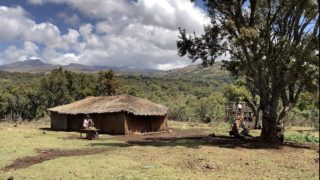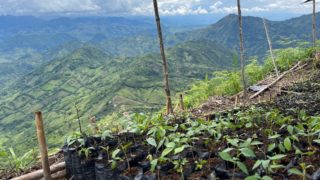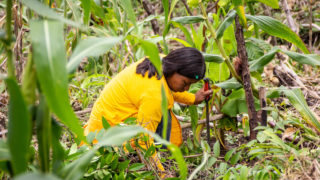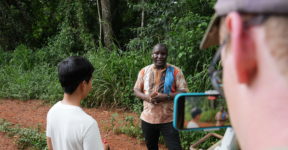
Climate and biodiversity finance: exploring the vital role of direct funding to indigenous peoples
Bilateral donors and philanthropists increasingly recognize that direct funding is crucial in realizing indigenous peoples’ human rights and their vital contributions to protecting the environment.
Indigenous peoples are playing critical roles in addressing the interrelated crises of biodiversity, desertification and climate change. They have a vital leadership role in environmental protection and make significant contributions to conservation, sustainable use and restoration. But they can only continue to do this if their collective human rights, including to lands, territories and resources, are protected. Far greater attention is now being paid to the conditions required to support their self-determined efforts to secure their rights. Direct funding is emerging as a crucial element of the climate and biodiversity funding ecosystem with inherent potential to address human rights and the environment holistically.
The interconnection between, and inseparability of, human rights and the environment - recognised by the United Nations Resolution on the Right to a Healthy Environment - means that the protection, promotion and fulfilment of human rights is essential to ensure positive environmental outcomes that in turn support diverse cultures, languages and ways of life. Securing indigenous peoples’ collective customary rights is a fundamental part of protecting all important ecosystems, including forests, and the rich array of biodiversity they support.

International climate and biodiversity agreements are increasingly recognizing the contributions of indigenous peoples and local communities. Recent global agreements that, to varying degrees, promote indigenous peoples’ human rights include the Glasgow Leaders’ Declaration on Forest and Land Use (2021), the Indigenous Peoples and Local Community Donor Pledge (2021), and the Kunming-Montreal Global Biodiversity Framework (2022).
Attention is now turning towards implementing these agreements. This entails considering the national-level policies and laws, and types of financial support needed to meet climate change goals, to reverse biodiversity loss, and development that promotes human rights, based on the self-determined priorities of indigenous peoples. Indigenous peoples are responding with thought leadership, developing principles and mechanisms which would best suit their contexts and needs. Rather than a ‘one size fits all’ approach, a mosaic of ideas and initiatives is emerging – and with these comes hope for potential pathways to more just, equitable and inclusive conservation and climate action.

The Embera Chamí of the Resguardo de Origen Colonial Cañamomo Lomaprieta in Colombia are undertaking an ambitious landscape restoration programme planting native trees to establish permanent forests to protect and steward critical sites in their territory. Photo credit: Viviane Weitzner, FPP
Indigenous peoples’ authorities and organizations, local community organizations, civil society, the International Funders for Indigenous Group and other allies have long called for increased support to be directed at locally determined solutions to the climate and biodiversity crises. Research has repeatedly identified a critical lack of access to appropriate forms of funding and support as a contributing factor that is limiting the impact that indigenous peoples can make in the fight against climate change, desertification and biodiversity loss.
In 2017, the then UN Special Rapporteur on the Rights of Indigenous Peoples, Victoria Tauli Corpuz, recommended that climate finance donors should take measures to respect and support the rights of indigenous peoples in climate financing and develop more dedicated direct funding mechanisms to support indigenous peoples’ own climate change initiatives.
The tipping point for coordinated action at the international level came at the United Nations Framework Convention on Climate Change Conference of Parties 26 in Glasgow, Scotland. The COP26 pledge on ‘Advancing Support for Indigenous Peoples’ and Local Communities’ Tenure Rights and their Forest Guardianship’ (often referred to as the ‘IPLC pledge’), made by 18 philanthropic donors and five governments – the UK, Norway, US, Netherlands and Germany – set out a combined financial commitment of $1.7 billion to “support the advancement of Indigenous Peoples’ and local communities’ forest tenure rights and greater recognition and rewards for their role as guardians of forests and nature.”
The IPLC Pledge marked an important commitment to contribute bilateral and philanthropic finance towards indigenous peoples’ and local community actions to secure their tenure rights. It also served to underscore the essential role that indigenous peoples play in people-centric, human rights-based conservation. It demonstrates an important shift in perception, one which recognizes indigenous peoples’ and local communities’ agency, human rights and cultural knowledge systems. The success of indigenous and local community management of the environment has been widely evidenced.
The IPLC Pledge shows an increased willingness by certain states and philanthropists to shift the historical power imbalance that led to a mere 1 per cent of official development aid (ODA) for climate mitigation and adaptation globally being allocated towards indigenous peoples’ and local communities’ tenure and forest management between 2011 and 2020. An even smaller fraction of this directly reached indigenous peoples’ and local community organizations.
The COP26 IPLC Pledge continues to represent an important starting point for direct funding. Yet, momentum towards delivering this pledge must continue and be built upon to ensure a greater proportion reaches indigenous people who are collectively tackling the root causes of our global and intertwined crises.
Greater emphasis on the role of direct funding may come from emerging initiatives related to the Kunming-Montreal Global Biodiversity Framework (GBF), adopted at the UN Convention on Biological Diversity (CBD) Conference of Parties 15 in 2022. The GBF embeds a rights-based approach across all targets. Target 19 specifically includes the need for global finance to enhance the role of collective actions including community-based natural resource management. The Global Environment Facility recently announced that it would seek to ensure that 20 per cent of the newly created Global Biodiversity Framework Fund would be used to support indigenous-led initiatives.

Baka community members near Ngloyla/Dja reserve, Cameroon, in a mapping workshop, working on sketch mapping and comparing to aerial imagery and GPS data. Credit: Tom Rowley, FPP
In 2022, representatives of philanthropic funders, indigenous peoples' organizations working at local, regional and global levels, academic research institutions and non-government organizations met for a side event at the Conference of the Parties to the CBD to explore how to improve direct and indirect financial and technical support that supports self-determination and context-specific climate and biodiversity actions. One of the key takeaways was the need to create new types of funding mechanisms with the full and effective participation of indigenous peoples.
Open communication between parties is the only way to ensure that there is shared understanding of what is needed to support indigenous peoples to manage, use, conserve and claim their lands and resources. This type of solidarity funding, based on trust, collaboration, cooperation and exchange, can also ensure that funding is able to support responsive activities often required in fast-changing contexts, alongside deeper structural changes that require longer-term funding.

Many indigenous-led organizations already have governance and financial management systems in place to receive and manage funding. Yet in certain contexts many barriers also exist to setting up an organization with the legal status necessary to receive funding. In other cases, indigenous organisations may not want to be involved in the administrative requirements that funding demands. This means that there is, in certain circumstances, still a role for certain types of ‘intermediary’ organizations which can accompany and support the receipt and administrative management of funds by indigenous partners, when they request it.
Such intermediary organizations derive their legitimacy from the peoples and organizations they support, and as such should be chosen and trusted by them – many will be chosen because they have been engaged in active and long-term partnerships that support the self-determined priorities and self-governance of indigenous peoples. A defining feature of intermediary organizations is their agility to meet the expressed need of indigenous peoples for allies and supporters in their struggles. They can provide specific technical skills that can help with navigating global, national and local issues and can complement existing skills and capacities of indigenous peoples.

A Kichwa woman tending her crops in Mishkiyakillu, Peru. Credit Vicki Brown, FPP
Indigenous people have responded in various ways on the subject of direct funding as a means to increase effective resourcing for climate and biodiversity action.
In one such response, indigenous peoples and allies are calling for the establishment of a permanent independent indigenous-led global funding mechanism. This would allow for direct negotiations with states and funders to ensure the recognition of their efforts towards enhanced biodiversity conservation, slowing and halting desertification, protecting all life, and effectively responding to the impacts of climate change. Such a mechanism would allow for greater decentralization of decision-making, increase accountability and ensure that projects being funded are selected, implemented and evaluated by indigenous peoples themselves.
Another response has been the establishment of the Shandia Platform, governed by representatives of the Global Alliance of Territorial Communities. Shandia seeks to guarantee timely access to direct funding by indigenous peoples and local communities through the redistribution of finance, such as that pledged by bilateral and philanthropic donors to the IPLC Pledge with whom the Shandia Platform interacts regularly. Funding will be focused on activities that strengthen the recognition of rights, community-based decision-making, management of territories, economics and energy, emergency response, cultural identity, and traditional knowledge.
There is also an increasing activism by indigenous peoples’ organizations, leaders and communities to change the way in which philanthropy is conducted. The Indigenous Ways of Giving + Sharing: Indigenous-led Funds Landscape Scan Report defines indigenous-led funds as those which are guided by indigenous worldviews, strengthens self-determination, and supports the empowerment of communities to change paradigms and shift power relations. Principles outlined include practical needs – supporting networking, creating platforms, and increasing indigenous leadership. Other principles are based on the types of values that donors need to adopt such as decolonised approaches, which relinquish top-down models that sustain unequal power dynamics. A concerted effort to shift the narrative around the perceived ‘risk’ of indigenous-led funds is also needed.
This focus on philanthropy reflects in part the higher degrees of flexibility that private-sector foundations can offer indigenous organizations and communities, but the actions and pledges of major donor governments remain critical as well, as demonstrated in the IPLC Pledge. Where governments commit funding to indigenous peoples, political support is implied or explicit – and such political support is essential for the success of self-determined development principles.
As various mechanisms evolve to best suit local contexts and diverse cultures, a range of direct funding initiatives will begin to reveal the possibilities that such backing offers – delivering positive human rights and environmental outcomes that recalibrate relationships and support the self-determination of indigenous peoples. Sustained commitment from philanthropists, bilateral and multilateral grants will be crucial to secure the positive impacts indigenous peoples have when their self-determination and self-governance are supported.
Acknowledgments
We’d like to thank Ramson Karmushu and Hindou Oumarou Ibrahim, who shared their insights at the Confronting Marginalisation in Climate Action and Conservation event during London Climate Week held by Chatham House and Forest Peoples Programme.
Ramson Karmushu is Head of the Research Program at IMPACT, Kenya and Hindou Oumarou Ibrahim is the Coordinator of Indigenous women and people’s association of Chad and co-chair of International Indigenous Peoples Forum on Climate Change, SDGs Advocate. This webinar is available to watch: Confronting marginalization in climate action and conservation (chathamhouse.org)


